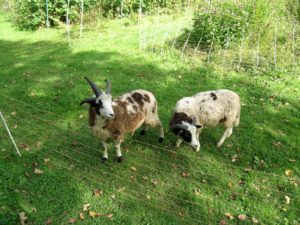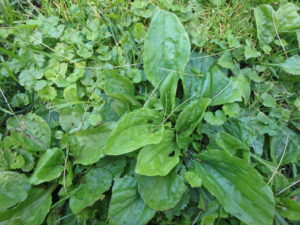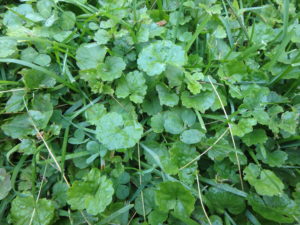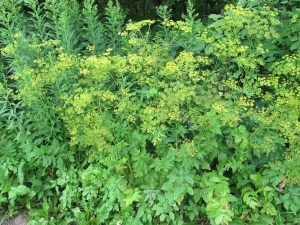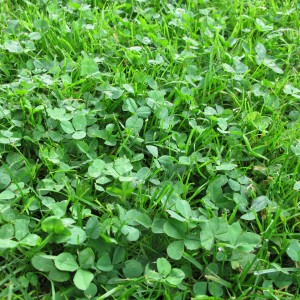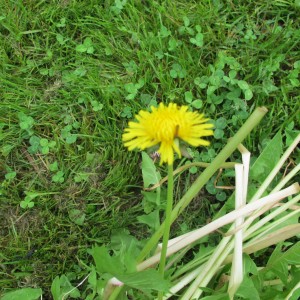How to Have a Better Lawn
Believe it or not, I once ate my lawnmower. No, not the Briggs and Stratton kind. I had purchased a pair of Jacobs sheep to keep my lawn trim for a season. At the end of the season they were off to the butcher, and came home freezer wrapped. It was an interesting experience, but not one I would recommend.
These rascals didn’t do an even job of cutting the lawn, and loved to butt me when I entered their pen.
To keep sheep as lawnmowers, I used a portable electric fence. It worked, but the sheep were always looking for trouble – they were teenage boy sheep, after all. They tried to (and did) reach through the fence to eat my flowers, get out of their enclosure, and trick me into thinking they were not interested in my trees and shrubs – only to attack them when I least expected it.
What is it with our fascination with lawns? Historically, lawns were maintained largely by the landed gentry. Peasants had neither the time nor the land for cultivating lawns. Maybe we all, deep down, want to be part of the nobility. But I think we like lawns because they promote tranquility and they are, with the advent of mowers, the easiest part of our landscape to maintain.
I am a minimalist when it comes to lawns. I don’t want a chemical-dependent lawn to fuss over. No fertilizers, fungicides, insecticides or moss killers for me. That said, there are things you can do to improve your lawn without too much trouble, and I think I have tried them all.
Over-seeding is one way to help your lawn. If you have places where the lawn is thin, first put down half an inch of fine compost or top soil. You will have to purchase this, I suspect, as homemade compost usually contains lumps like egg shells and undigested orange peels. Many garden centers have nice compost for sale by the tractor scoop ready for your pick-up truck, and all have bagged compost.
Fling compost over the lawn with a shovel, and spread it out with a lawn rake. Then apply lawn seed, and drag the lawn rake over the seed and compost – with the rake tines up, not down. The tines will mix the seeds and compost or soil.Where you have shady lawn, buy lawn seed for shady places.
Watering is key. Seeds need moisture to germinate, and a hot sunny day will dry out seeds quickly. Some people like to spread a thin layer of straw over the seeded area to shade the seeds and minimize drying. At this time of year it will take about a week for grass to start growing (but much longer in the spring when the soil is cold.) Water every day unless it rains. I generally plant when 3 days of rainy weather is forecast.
What about fertilizer? Most states prohibit using phosphorous-containing fertilizers on lawns (to protect streams and ponds). ) On a bag of 5-10-5 fertilizer, for example, it’s the middle number (10). There are now special fertilizers for lawns, but if you are adding compost, it will help provide adequate nutrition for your lawn.
Grass grows best when the soil is around neutral.
For about $5 you can buy a soil pH test kit to see if yours is in the range of 6.0 to 7.0, which is ideal. The kits are easy to use: put some soil into a glass vial, add their magic powder, then add water. Shake, and the water will change color. You just decide which of the pictures on the kit best matches the color of your solution. They say to use distilled water, as it won’t affect the results. It’s available at the pharmacy.
If your soil is acidic (technically below 7.0), you may want to add some limestone to the lawn. But don’t bother unless the soil is quite acidic, say in the 4.5 to 5.9 range. Read the directions on the bag, and add the appropriate amount. I just use a can and sprinkle it over small areas.
Height of the grass is important to a lawn, too. I once got to interview Joe Mooney, the head groundskeeper at Fenway Park, home of my beloved Red Sox. He maintained the infield at a height of three quarters of an inch! Lawn that short stresses the plants, so he also had a dungeon under the stands full of chemical fertilizers and fungicides.
The longer you keep the lawn, the more food a grass plant can make, so the healthier it will be. Cutting grass at three inches is good. Yes, shorter looks neater, perhaps, but taller grass will also help shade out annual weeds and crabgrass.
What about those weeds? Does it really matter that you have some? People write to me all the time complaining about Creeping Charlie (Glechoma hederacea) in their lawns. Charlie is like death and taxes, you can’t avoid him without killing everything else, including your lawn grasses. So ignore Creeping Charlie. I also ignore plantain, dandelions and other weeds.
Accept weeds, and your blood pressure will go down, and your summer will be better. “If it is green and I can mow it, it’s a lawn.” That’s my motto. The only weeds I dig out are thistles, as they hurt bare feet! Chemicals? I don’t want my grandkids and pets absorbing them as they walk barefoot across the lawn.
Read Henry’s blog athttps://dailyuv.com/
Fall Lawn Care
This is a good time to do some improvements on your lawn. If you have crabgrass, lawn ivy (Creeping Charlie) or bare spots where the kids played badminton, now is the time to get to work. I recently called Paul Sachs, owner of North Country Organics and the author of three books on lawn care. He gave me some good suggestions.
Testing pH is a good first step, Sachs said. If your soil is too acidic or too alkaline, minerals can be bound up and unavailable to your turf plants even if they are present. You can get a simple test kit at a garden center, or take a sample and mail it to your state Extension Service soil testing lab for a more extensive report.
He warned that the first time someone adds limestone to their lawn – and fall is a good time for that – they may see a remarkable improvement the following spring. But, he warned, don’t keep on adding limestone without testing the pH. If you keep adding limestone every year your pH can get quite alkaline, which is just as bad as being too acidic.
According to Sachs, fall is a good time to overseed your lawn if you have thin or worn places, or if you have crabgrass. The soil is warm now, so new grass seeds will germinate more quickly than in the spring. Crabgrass, an annual, is declining in vigor so you can crowd it out by adding seed. Crabgrass seeds are not going to germinate until the spring, but if you can establish a nice thick turf now, crabgrass will have a hard time competing with it next spring.
It is best to sow a mixture of kinds of seed – a conservation mix that contains something like this: 35 percent creeping red fescue, 25 percent turf type tall fescue, 10 percent Kentucky bluegrass, 12 percent turf type perennial ryegrass, 15 percent annual ryegrass and 3 percent white clover. That mixture is good for a variety of soils and will thrive in full sun or even moderate shade.
Sachs told me that before you overseed an area, you should lower the height of the blades on your mower and give it a good haircut. That will allow newly started grass seeds to get more sunshine, which is important when it is getting established. So when filling in thin spots, you want to cut the grass close and allow new plants to develop.
Fall is also a good time to thicken the lawn by providing some fertilizer. An organic fertilizer like Pro-Gro will help roots to bulk up and winter-over better. Paul Sachs told me that when adding fertilizer it is good to keep the blades of mower up high, allowing each grass plant to have more surface area for photosynthesis. That will help to pump up its roots.
Knowing how much fertilizer to add and then figuring out how to spread it at the proper rate is a job for Einstein, I always thought. Paul Sachs helped me with the calculation. In general, he said you should add 20 to 30 pounds of fertilizer per 1,000 square feet of lawn if using Pro-Gro or other organic fertilizer with a 5-3-4 nutrient analysis (5-3-4 means 5 lbs of nitrogen, 4 of phosphate, 3 of potash per hundred weight).
A 20 by 50 foot section of lawn is 1,000 square feet. Figure out the total square footage of your lawn, calculate the amount of fertilizer you need for the job, and then buy the appropriate number of bags. Start applying it in a push-type spreader. If you set your spreader for a low rate of distribution, you can go over the lawn more than once until you have used all the fertilizer. Done. If part of the lawn got a little more than another part, no big deal – so long as every part of the lawn got some fertilizer.
Compaction makes it difficult to for grasses to thrive – except crabgrass, of course. That’s why crabgrass invades areas where you frequently walk. Years ago Sachs told me a simple way to test for compaction: you should be able to push a screwdriver with a 6-inch shaft into the lawn with moderate force. If you can’t, the lawn needs help.
You could hire a landscaper to come with a core-aerator or you could try to do something yourself. On-line I found an aerator at Sears for about $100 that can be pulled behind a riding lawn mower. It has 10 sharp steel stars that rotate and poke small 2-inch deep holes.
And then were the aerator sandals that strap onto your shoes with spikes that poke holes in the soil – only $16 but it would seem like a lot of work to aerate the lawn that way. Sachs said, “If you stomp your feet into really compacted soil, the only way to escape is to undo the straps and pry them out with your hands. I learned what it must feel like when a fly lands on fly paper.”
What about that pesky lawn ivy, commonly called Creeping Charlie? It is in the mint family and will grow almost anywhere. Sachs suggested raking it out with a short-tined garden and then fertilizing and overseeding. I tried raking it out, but found I pulled out my lawn grass, too. So maybe we just have to live with it. After all, if it’s green and you can mow it, I say it’s a lawn.
Henry is a gardening consultant and the author of 5 books. His website is www.Gardening-Guy.com. He lives and gardens in Cornish Flat, NH.
Spring Lawn Care
I love lawns. Not big lawns, and they don’t need to be pure Kentucky bluegrass, either. I love a little bit of mowed green that has some grass and clover; it can have a few dandelions or bluets or violets, too. I can live with Creeping Charlie (also called ground ivy or by its scientific name, Glechoma hederacea). Overall my philosophy is this: if it’s green and you can mow it, it’s a lawn. Only thistles and other sharp things need to be dug out- but never nuked with chemicals.
Despite that philosophy, people often remark on how lush and thick my lawn is, and how nice it feels underfoot. Having a nice lawn is easy if you follow a few simple rules.
First, stop worrying about it. And certainly never add any chemicals to it. Weed-‘n’-feed formulas kill off not only the broad-leafed plants like dandelions, they also diminish the biological activity in the soil. I want a healthy soil full of microbes (including bacteria and fungi) and know that many microbes are killed or adversely affected by chemicals.
Chemical fertilizers are made of salts of nitrogen, phosphorus and potassium. These have the ability to dry out and kill microbes. And of course if your product includes chemicals for killing moss, weeds, fungi or insects, all those chemicals add to the killing power. Your soil cringes when you load up the spreader with weed-‘n’-feed.
If you want to have a good healthy lawn, you need good healthy soil. It needs about 6 inches of reasonably good soil that drains well (so as not to drown the lawn grasses) but is not so sandy that it dries out in an afternoon. Cut and peel back a one-foot square piece of sod after a rainstorm, and look at the soil. Grab a handful of soil. Does it form a cylinder in your hand when you squeeze it, and hold its shape when you open your fingers? If so, you have clay, or a clay-based soil.
If you perform the squeeze test on sandy soil, it will crumble apart when you open your fingers. When you rub the soil between your fingers, you will feel sharp grains of sand. But if you have a nice loam, the soil with be dark and the cylinder will fall apart if you touch it with a finger.
If you are not happy with your lawn, I suggest getting your soil tested. The Extension Service in most states will have on-line instructions on how to take a soil sample, and where to send it. Some garden centers have kits for sale. Find out what kind of soil you have, what it needs, and if your soil pH is in the right zone.
Soil pH is a measure of how acidic or alkaline your soil is. Lawns do best when the soil pH is near neutral (which is 7.0) or slightly acidic. Our rain is acidic, and neglected soils – including most lawns – have soil that is pretty acidic. You can fix this easily by adding limestone to the lawn, and a pH test will tell you how much to add to balance it out. If your soil is too far from neutral, some soil minerals will become unavailable to the grass plants, even if the minerals are there. You can add limestone at any time, though most lawn experts recommend the fall so that it will have time to do its work before spring growth begins.
The other additive that helps an anemic lawn is compost or organic matter. Good crumbly compost can be flung around the lawn with a shovel and then raked out to provide even coverage. Doing that now would help. Earthworms in a healthy lawn will be more than willing to eat that compost and then excrete the nutritious ingredients into the soil.
Earthworms, fungi and bacteria will also help you improve your lawn by breaking down your grass clippings. Those clippings will add organic matter and enrich your soil. So cut your lawn regularly – avoiding a thick layer of clippings that needs to be bagged or raked.
Lawn height is critical for a good, easy-care lawn. Get out of the golf course mindset. This is a lawn, not a putting green! I set my mower, generally, one notch down from the highest setting. Right by the front door I keep it a little shorter at times.
Why keep your lawn long? Your lawn is made of millions of plants, and each one can only create a healthy root system if you let it have enough blade to create its own food by photosynthesis. Too short? The roots will be stunted, and the lawn will not be healthy. And the taller the grass, the more it can shade out annual weeds and crabgrass.
Think about it: if there were daffodils that we could mow down only to have them bloom again, we would pay big bucks for them. But call those yellow flowers dandelions, and it’s war. I hope you’ll re-think your position about lawn chemicals if you’re in the weed-‘n’-feed school. Diversity of plant types in the lawn helps to create a lush, lovely green space.
Henry Homeyer is a garden designer and the author of 4 gardening books and a children’s chapter book. His Web site is www.Gardening-Guy.com.



